Development of a 1 TW/35 fs Ti:sapphire Laser Amplifier and Generation of Intense THz Waves Using Two-Color Laser Filamentation
Abstract
:1. Introduction
2. Development of the 1 TW/35 fs Ti:sapphire Laser Amplifier System
2.1. Overall Configuration
2.2. 4-pass Ti:sapphire Amplifier and Pulse Compression
3. Experimental Results for Two-Color-Based Intense THz Wave Generation Using the Laser Amplifier
4. Conclusions
Author Contributions
Funding
Data Availability Statement
Acknowledgments
Conflicts of Interest
References
- Maiman, T.H. Stimulated optical radiation in ruby. Nature 1960, 187, 493–494. [Google Scholar] [CrossRef]
- Sixty years of lasers. Nat. Rev. Phys. 2020, 2, 221. [CrossRef]
- Strickland, D.; Mourou, G. Compression of amplified chirped optical pulses. Opt. Commun. 1985, 55, 447–449. [Google Scholar] [CrossRef]
- Yoon, J.W.; Jeon, C.; Shin, J.; Lee, S.K.; Lee, H.W.; Choi, I.W.; Kim, H.T.; Sung, J.H.; Nam, C.H. Achieving the laser intensity of 5.5 × 1022 W/cm2 with a wavefront-corrected multi-PW laser. Opt. Express 2019, 27, 20412–20420. [Google Scholar] [CrossRef]
- Tanaka, K.A.; Spohr, K.M.; Balabanski, D.L.; Balascuta, S.; Capponi, L.; Cernaianu, M.O.; Cuciuc, M.; Cucoanes, A.; Dancus, I.; Dhal, A.; et al. Current status and highlights of the ELI-NP research program. Matter Radiat. Extremes 2020, 5, 024402. [Google Scholar] [CrossRef] [Green Version]
- Gonsalves, A.J.; Nakamura, K.; Daniels, J.; Benedetti, C.; Pieronek, C.; de Raadt, T.C.H.; Steinke, S.; Bin, J.H.; Bulanov, S.S.; van Tilborg, J.; et al. Petawatt laser guiding and electron beam acceleration to 8 GeV in a laser-heated capillary discharge waveguide. Phys. Rev. Lett. 2019, 122, 084801. [Google Scholar] [CrossRef] [Green Version]
- Ke, L.; Yu, C.; Feng, K.; Qin, Z.; Jiang, K.; Wang, H.; Luan, S.; Yang, X.; Xu, Y.; Leng, Y.; et al. Optimization of electron beams based on plasma-density modulation in a laser-driven wakefield accelerator. Appl. Sci. 2021, 11, 2560. [Google Scholar] [CrossRef]
- Leemans, W.P.; Gonsalves, A.J.; Mao, H.S.; Nakamura, K.; Benedetti, C.; Schroeder, C.B.; Tóth, C.; Daniels, J.; Mittelberger, D.E.; Bulanov, S.S.; et al. Multi-GeV electron beams from capillary-discharge-guided subpetawatt laser pulses in the self-trapping regime. Phys. Rev. Lett. 2014, 113, 245002. [Google Scholar] [CrossRef] [Green Version]
- Polz, J.; Robinson, A.P.L.; Kalinin, A.; Becker, G.A.; Fraga, R.A.C.; Hellwing, M.; Hornung, M.; Keppler, S.; Kessler, A.; Klöpfel, D.; et al. Efficient laser-driven proton acceleration from a cccryogenic solid hydrogen target. Sci. Rep. 2019, 9, 16534. [Google Scholar] [CrossRef]
- Bagchi, S.; Tayyab, M.; Pasley, J.; Robinson, A.P.L.; Nayak, M.; Chakera, J.A. Quasi mono-energetic heavy ion acceleration from layered targets. Phys. Plasmas 2021, 28, 023108. [Google Scholar] [CrossRef]
- Zhu, X.-L.; Chen, M.; Weng, S.-M.; Yu, T.-P.; Wang, W.-M.; He, F.; Sheng, Z.-M.; McKenna, P.; Jaroszynski, D.A.; Zhang, J. Extremely brilliant GeV γ-rays from a two-stage laser-plasma accelerator. Sci. Adv. 2020, 6, 7240. [Google Scholar] [CrossRef] [PubMed]
- Kozlova, M.; Andriyash, I.; Gautier, J.; Sebban, S.; Smartsev, S.; Jourdain, N.; Chulagain, U.; Azamoum, Y.; Tafzi, A.; Goddet, J.-P.; et al. Hard X-rays from laser-wakefield accelerators in density tailored plasmas. Phys. Rev. X 2020, 10, 011061. [Google Scholar] [CrossRef] [Green Version]
- Kim, K.Y.; Taylor, A.J.; Glownia, J.H.; Rodriguez, G. Coherent control of terahertz supercontinuum generation in ultrafast laser–gas interactions. Nat. Photonics 2008, 2, 605–609. [Google Scholar] [CrossRef]
- He, Z.-H.; Thomas, A.G.R.; Beaurepaire, B.; Nees, J.A.; Hou, B.; Malka, V.; Krushelnick, K.; Faure, J. Electron diffraction using ultrafast electron bunches from a laser-wakefield accelerator at kHz repetition rate. Appl. Phys. Lett. 2013, 102, 064104. [Google Scholar] [CrossRef] [Green Version]
- Bonvalet, A.; Darmon, A.; Lambry, J.C.; Martin, J.L.; Audebert, P. 1 kHz tabletop ultrashort hard X-ray source for time-resolved X-ray protein crystallography. Opt. Lett. 2006, 31, 2753–2755. [Google Scholar] [CrossRef] [Green Version]
- Raksi, F.; Wilson, K.R.; Jiang, Z.M.; Ikhlef, A.; Cote, C.Y.; Kieffer, J.C. Ultrafast X-ray absorption probing of a chemical reaction. J. Chem. Phys. 1996, 104, 6066–6069. [Google Scholar] [CrossRef]
- Tonouchi, M. Cutting-edge terahertz technology. Nat. Photonics 2007, 1, 97–105. [Google Scholar] [CrossRef]
- Dhillon, S.S.; Vitiello, M.S.; Linfield, E.H.; Davies, A.; Hoffmann, M.; Booske, J.; Paoloni, C.; Gensch, M.; Weightman, P.; Williams, G.P.; et al. The 2017 terahertz science and technology roadmap. J. Phys. D Appl. Phys. 2017, 50, 043001. [Google Scholar] [CrossRef]
- Treacy, E. Optical pulse compression with diffraction gratings. IEEE J. Quantum Electron. 1969, 5, 454–458. [Google Scholar] [CrossRef]
- Frantz, L.M.; Nodvik, J.S. Theory of pulse propagation in a laser amplifier. J. Appl. Phys. 1963, 34, 2346–2349. [Google Scholar] [CrossRef]
- Salin, F. How to Manipulate and Change the Characteristics of Laser Pulses. In Femtosecond Laser Pulses, 2nd ed.; Rulliere, C., Ed.; Springer Science Business Media, Inc.: New York, NY, USA, 2005; pp. 175–194. [Google Scholar] [CrossRef]
- Perry, M.D.; Mourou, G. Terawatt to Petawatt subpicosecond lasers. Science 1994, 264, 917. [Google Scholar] [CrossRef]
- Moulton, P.F. Spectroscopic and laser characteristics of Ti:Al2O3. J. Opt. Soc. Am. B 1986, 3, 125–133. [Google Scholar] [CrossRef]
- Kane, D.J.; Trebino, R. Characterization of arbitrary femtosecond pulses using frequency resolved optical gating. IEEE J. Quantum Electron. 1993, 29, 571–579. [Google Scholar] [CrossRef]
- Kane, D.J.; Taylor, A.J.; Trebino, R.; DeLong, K.W. Single-shot measurement of the intensity and phase of a femtosecond UV laser pulse using frequency-resolved optical gating. Opt. Lett. 1994, 19, 1061–1063. [Google Scholar] [CrossRef]
- Trebino, R.; DeLong, K.W.; Fittinghoff, D.N.; Sweetser, J.N.; Krumbügel, M.A.; Kane, D.J. Measuring ultrashort laser pulses in the time-frequency domain using frequency-resolved optical gating. Rev. Sci. Instrum. 1997, 68, 3277–3295. [Google Scholar] [CrossRef]
- Fourmaux, S.; Payeur, S.; Buffechoux, S.; Lassonde, P.; St-Pierre, C.; Martin, F.; Kieffer, J.C. Pedestal cleaning for high laser pulse contrast ratio with a 100 TW class laser system. Opt. Express 2011, 19, 8486–8497. [Google Scholar] [CrossRef]
- McKenna, P.; Lindau, F.; Lundh, O.; Neely, D.; Persson, A.; Wahlström, C.-G. High-intensity laser-driven proton acceleration: Influence of pulse contrast. Philos. Trans. Royal Soc. A 2006, 364, 711–723. [Google Scholar] [CrossRef] [Green Version]
- Cook, D.J.; Hochstrasser, R.M. Intense terahertz pulses by four-wave rectification in air. Opt. Lett. 2000, 25, 1210–1212. [Google Scholar] [CrossRef]
- Kress, M.; Löffler, T.; Eden, S.; Thomson, M.; Roskos, H.G. Terahertz-pulse generation by photoionization of air with laser pulses composed of both fundamental and second-harmonic waves. Opt. Lett. 2004, 29, 1120–1122. [Google Scholar] [CrossRef]
- Kim, K.-Y.; Glownia, J.H.; Taylor, A.J.; Rodriguez, G. Terahertz emission from ultrafast ionizing air in symmetry-broken laser fields. Opt. Express 2007, 15, 4577–4584. [Google Scholar] [CrossRef] [PubMed]
- Dandl, T.; Heindl, T.; Ulrich, A. Fluorescence of nitrogen and air. J. Instrum. 2012, 7, P11005. [Google Scholar] [CrossRef]
- Gallot, G.; Grischkowsky, D. Electro-optic detection of terahertz radiation. J. Opt. Soc. Am. B 1999, 16, 1204–1212. [Google Scholar] [CrossRef]
- Jang, D.; Uhm, H.S.; Jang, D.; Hur, M.S.; Suk, H. Electron density characterization of inductively-coupled argon plasmas by the terahertz time-domain spectroscopy. Plasma Sources Sci. Technol. 2016, 25, 065008. [Google Scholar] [CrossRef]
- Neu, J.; Schmuttenmaer, C.A. Tutorial: An introduction to terahertz time domain spectroscopy (THz-TDS). J. Appl. Phys. 2018, 124, 231101. [Google Scholar] [CrossRef] [Green Version]
- Kaltenecker, K.J.; Kelleher, E.J.R.; Zhou, B.; Jepsen, P.U. Attenuation of THz beams: A “how to” tutorial. J. Infrared Millim. Terahertz Waves 2019, 40, 878–904. [Google Scholar] [CrossRef] [Green Version]
- Blanchard, F.; Razzari, L.; Bandulet, H.-C.; Sharma, G.; Morandotti, R.; Kieffer, J.-C.; Ozaki, T.; Reid, M.; Tiedje, H.; Haugen, H. Generation of 1.5 μJ single-cycle terahertz pulses by optical rectification from a large aperture ZnTe crystal. Opt. Express 2007, 15, 13212–13220. [Google Scholar] [CrossRef] [PubMed]
- Gallot, G.; Zhang, J.; McGowan, R.W.; Jeon, T.-I.; Grischkowsky, D. Measurements of the THz absorption and dispersion of ZnTe and their relevance to the electro-optic detection of THz radiation. Appl. Phys. Lett. 1999, 74, 3450–3452. [Google Scholar] [CrossRef] [Green Version]
- Arber, T.D.; Bennett, K.; Brady, C.S.; Lawrence-Douglas, A.; Ramsay, M.G.; Sircombe, N.J.; Gillies, P.; Evans, R.G.; Schmitz, H.; Bell, A.R.; et al. Contemporary particle-in-cell approach to laser-plasma modelling. Plasma Phys. Control. Fusion 2015, 57, 113001. [Google Scholar] [CrossRef]
- Esarey, E.; Sprangle, P.; Krall, J.; Ting, A. Self-focusing and guiding of short laser pulses in ionizing gases and plasmas. IEEE J. Quantum Electron. 1997, 33, 1879–1914. [Google Scholar] [CrossRef]
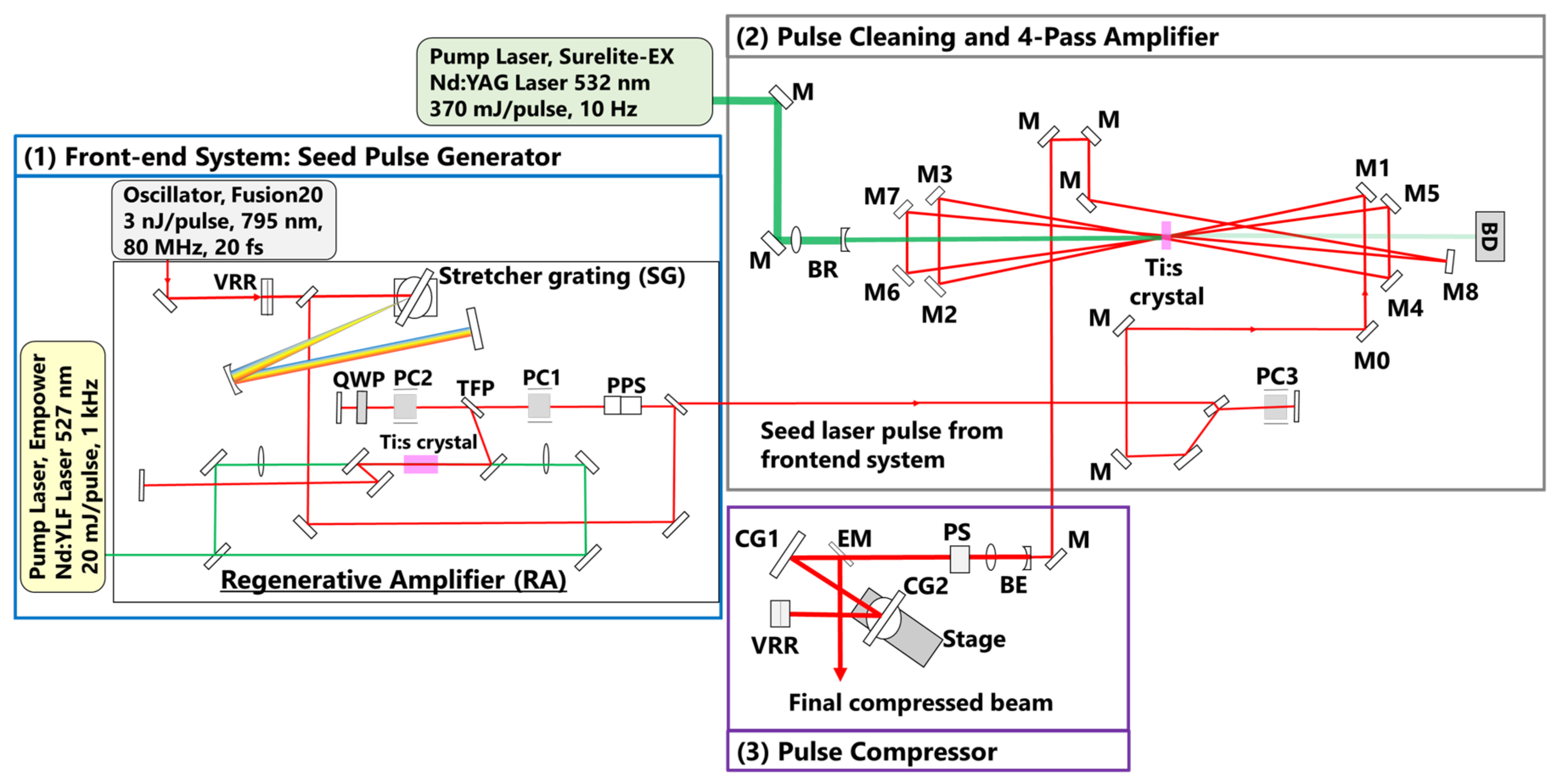
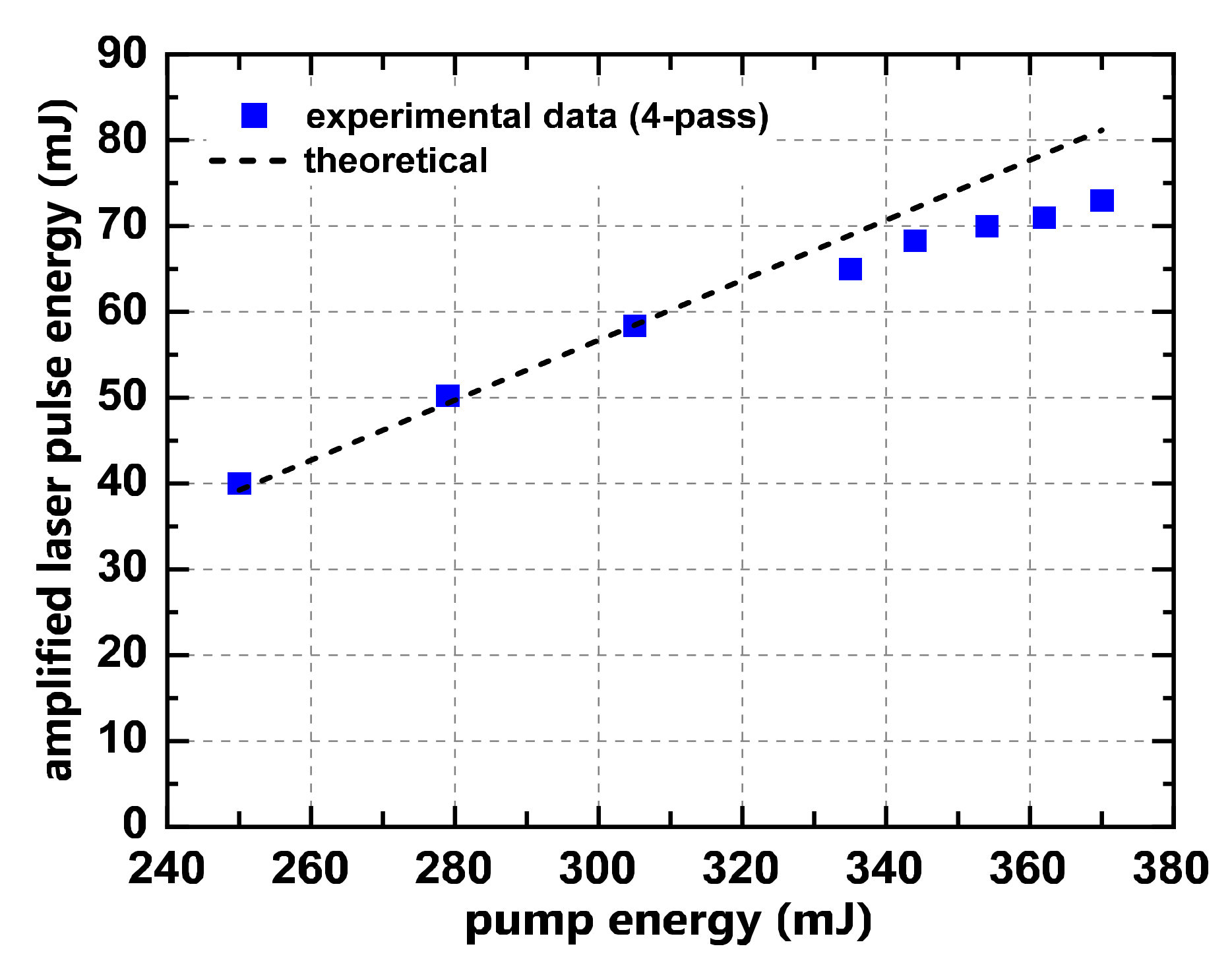

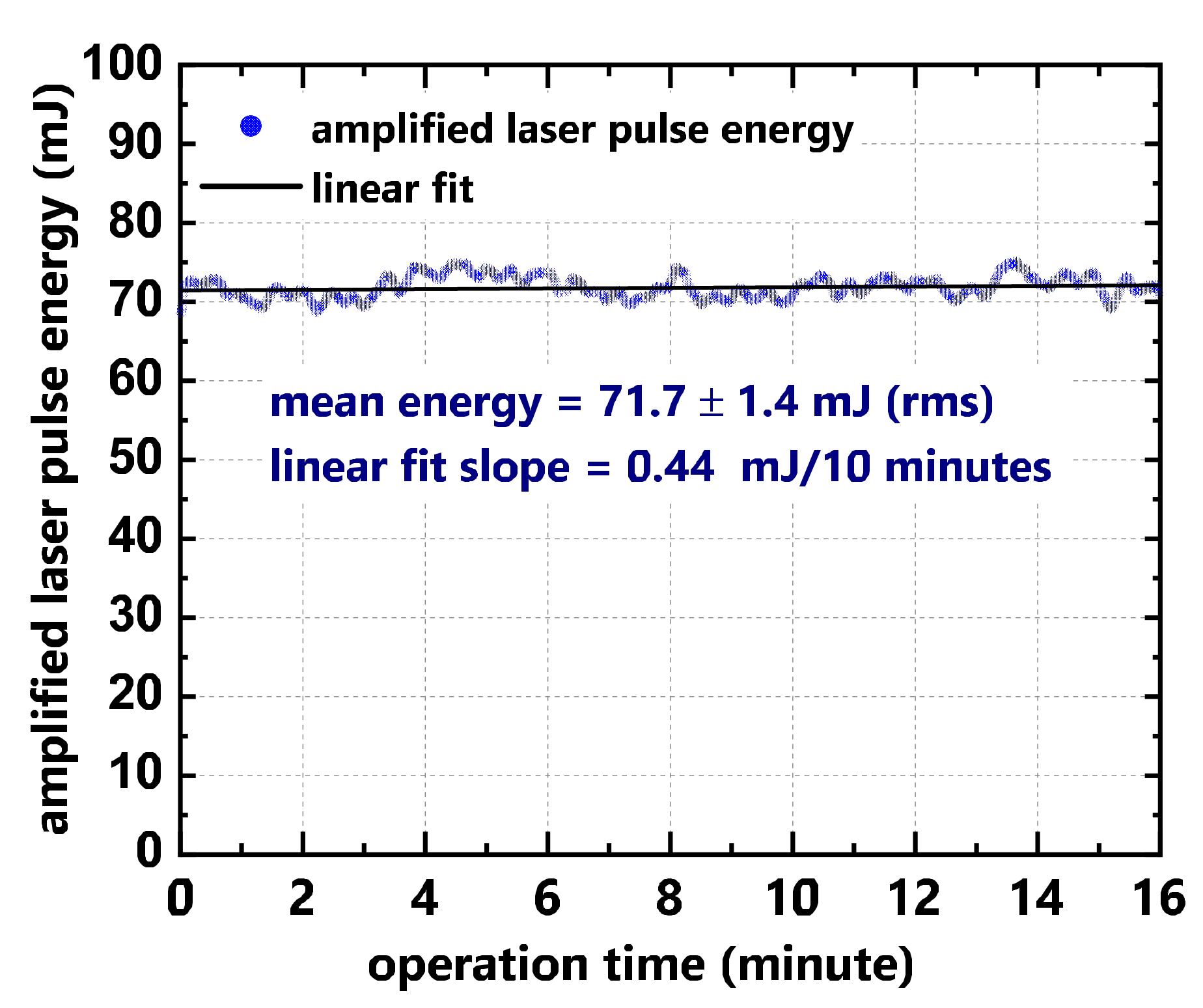
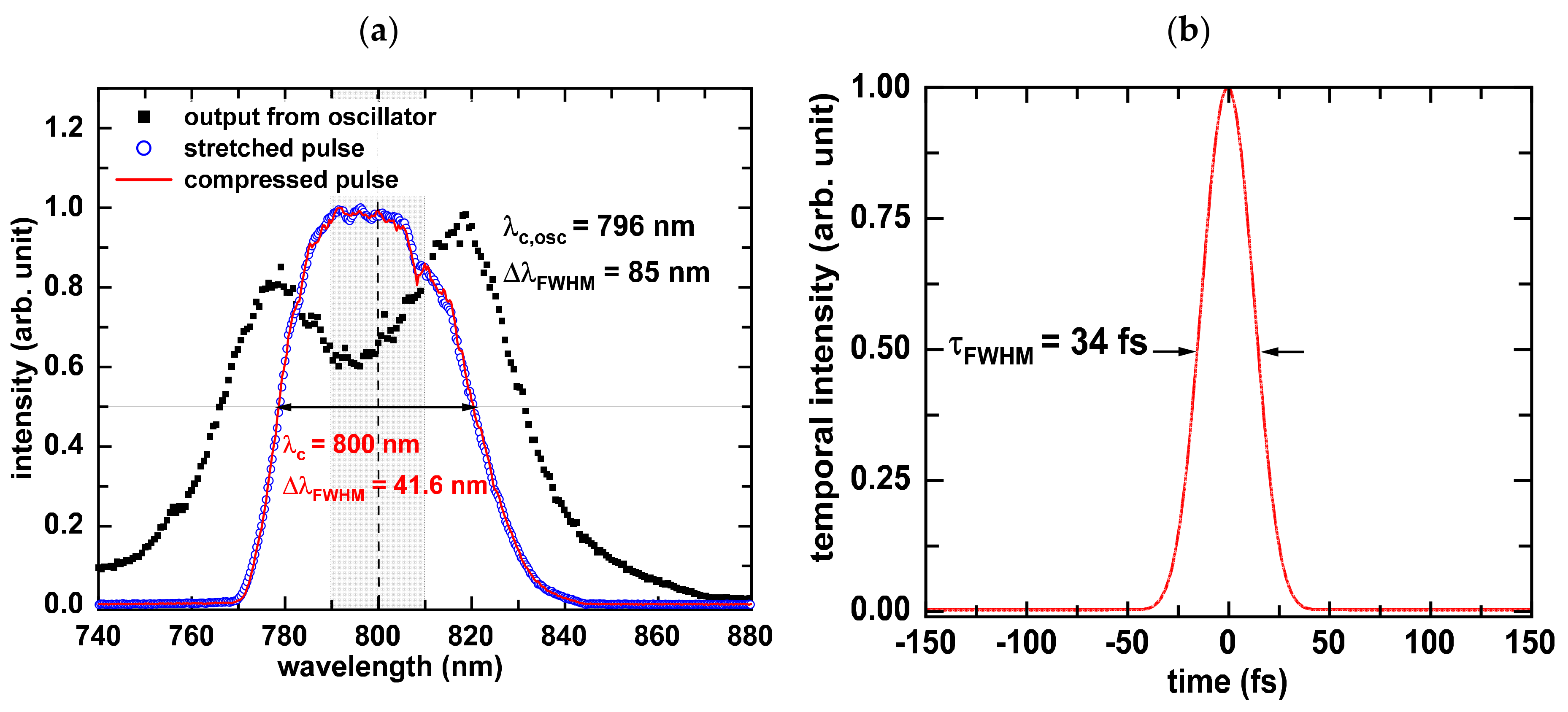
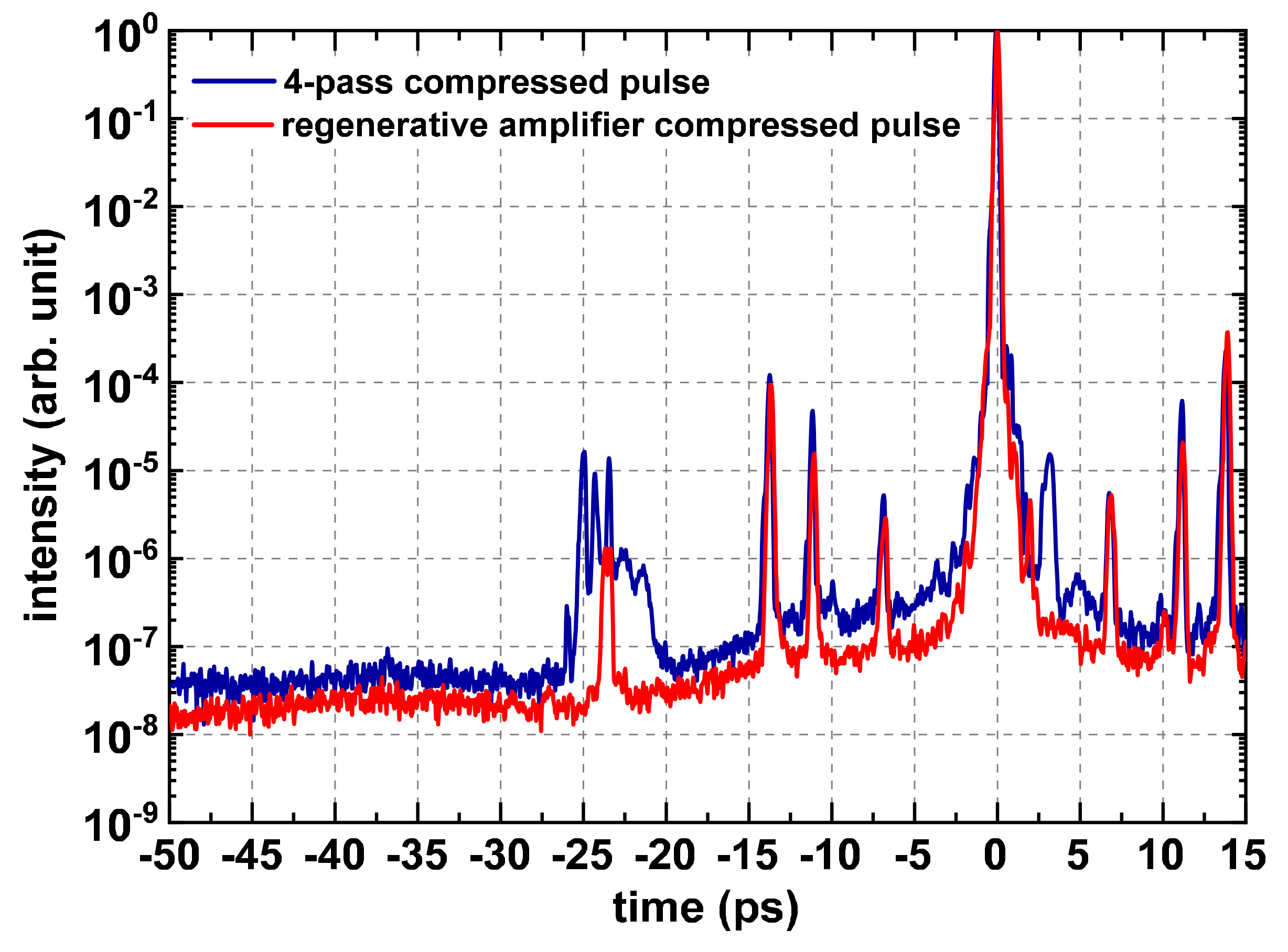

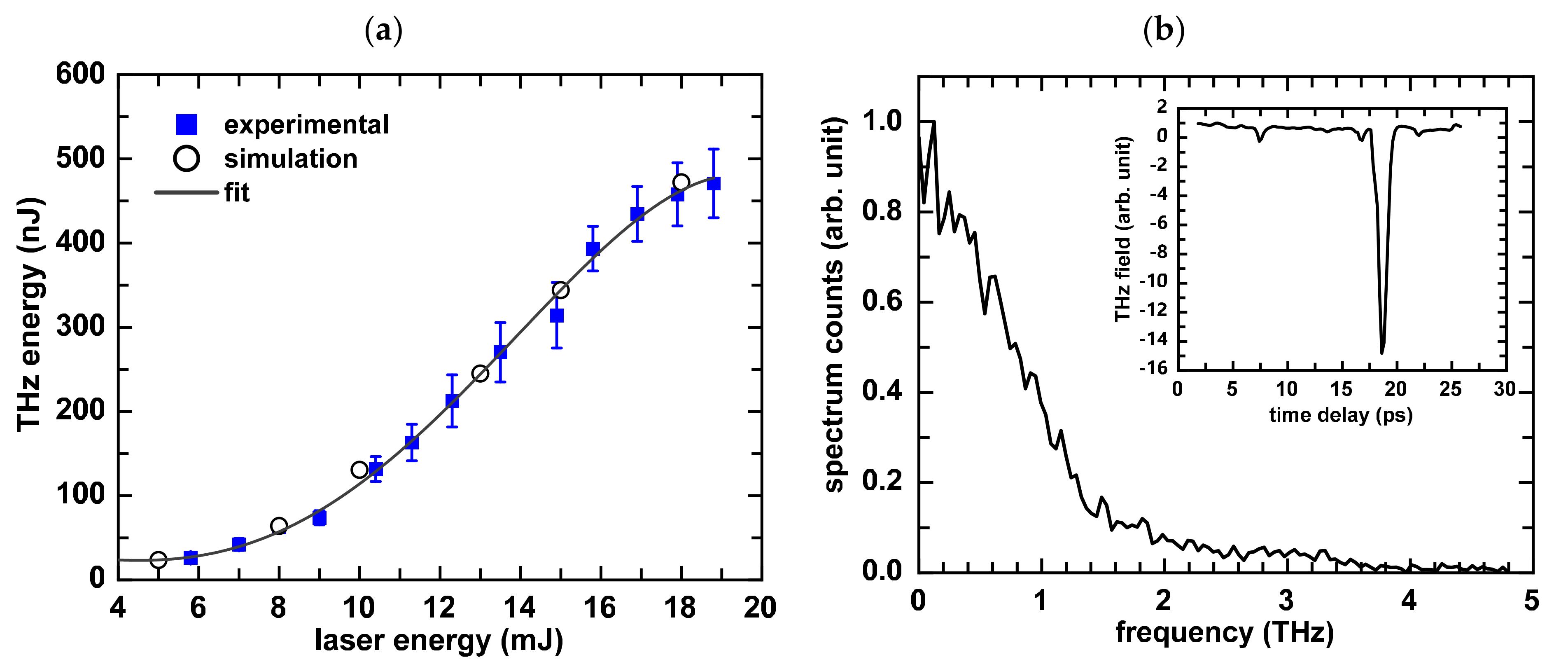
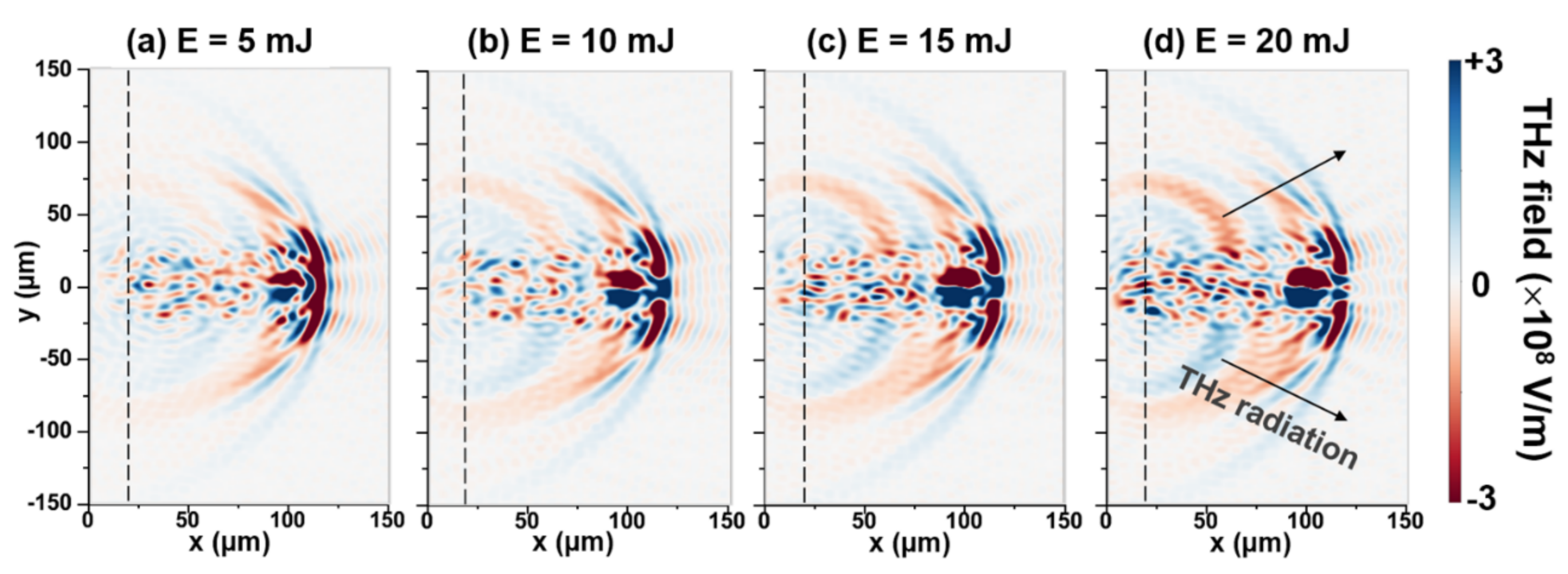
Publisher’s Note: MDPI stays neutral with regard to jurisdictional claims in published maps and institutional affiliations. |
© 2021 by the authors. Licensee MDPI, Basel, Switzerland. This article is an open access article distributed under the terms and conditions of the Creative Commons Attribution (CC BY) license (https://creativecommons.org/licenses/by/4.0/).
Share and Cite
Phung, V.L.J.; Kang, K.; Jeon, S.; Kim, J.; Roh, K.; Suk, H. Development of a 1 TW/35 fs Ti:sapphire Laser Amplifier and Generation of Intense THz Waves Using Two-Color Laser Filamentation. Photonics 2021, 8, 316. https://doi.org/10.3390/photonics8080316
Phung VLJ, Kang K, Jeon S, Kim J, Roh K, Suk H. Development of a 1 TW/35 fs Ti:sapphire Laser Amplifier and Generation of Intense THz Waves Using Two-Color Laser Filamentation. Photonics. 2021; 8(8):316. https://doi.org/10.3390/photonics8080316
Chicago/Turabian StylePhung, Vanessa Ling Jen, Keekon Kang, Seongjin Jeon, Jinju Kim, Kyungmin Roh, and Hyyong Suk. 2021. "Development of a 1 TW/35 fs Ti:sapphire Laser Amplifier and Generation of Intense THz Waves Using Two-Color Laser Filamentation" Photonics 8, no. 8: 316. https://doi.org/10.3390/photonics8080316
APA StylePhung, V. L. J., Kang, K., Jeon, S., Kim, J., Roh, K., & Suk, H. (2021). Development of a 1 TW/35 fs Ti:sapphire Laser Amplifier and Generation of Intense THz Waves Using Two-Color Laser Filamentation. Photonics, 8(8), 316. https://doi.org/10.3390/photonics8080316




